
HOME
INTRO
SYMBOLS
ALMANAC
ECONOMY
GEOGRAPHY
STATE MAPS
PEOPLE
FORUM
NEWS
COOL SCHOOLS
STATE QUIZ
STATE LINKS
BOOK STORE
MARKETPLACE
GUESTBOOK
CONTACT US


James Knox Polk (1795-1849)
In Article II, Section 1 of the Constitution of the United States of America, the following requirements are stipulated for those wishing to hold the office of the President of the United States.
No person except a natural born Citizen, or a Citizen of the United States, at the time of the Adoption of this Constitution, shall be eligible to the Office of President; neither shall any Person be eligible to that Office who shall not have attained to the Age of thirty-five Years, and been fourteen Years a Resident within the United States.
11th President of the United States (1845-1849)
Often referred to as the first "dark horse" President, James K. Polk was the last of the Jacksonians to sit in the White House, and the last strong President until the Civil War.
He was born in Mecklenburg County, North Carolina, in 1795. Studious and industrious, Polk was graduated with honors in 1818 from the University of North Carolina. As a young lawyer he entered politics, served in the Tennessee legislature, and became a friend of Andrew Jackson.
In the House of Representatives, Polk was a chief lieutenant of Jackson in his Bank war. He served as Speaker between 1835 and 1839, leaving to become Governor of Tennessee.
| James K. Polk: | |
|---|---|
| Source: University of Virginia: Miller Center of Public Affairs, James Polk, 28 November 2009 <www.millercenter.virginia.edu>. | |
| 11th President of the United States | |
| Born: | November 2, 1795, Mecklenburg County, North Carolina. |
| Nickname: | "Young Hickory" |
| Education: | University of North Carolina (graduated 1818) |
| Religion: | Presbyterian |
| Marriage: | January 1, 1824, to Sarah Childress (1803-1891) |
| Children: | None. |
| Career: | Lawyer |
| Political Party: | Democrat |
| President: | 1 term (4 years) from 1845-1849. |
| Age at inauguration: | 49 |
| Died: | June 15, 1849, Nashville, Tennessee. |
| Interred: | State Capitol Grounds, Nashville, Tennessee. |
Until circumstances raised Polk's ambitions, he was a leading contender for the Democratic nomination for Vice President in 1844. Both Martin Van Buren, who had been expected to win the Democratic nomination for President, and Henry Clay, who was to be the Whig nominee, tried to take the expansionist issue out of the campaign by declaring themselves opposed to the annexation of Texas. Polk, however, publicly asserted that Texas should be "re-annexed" and all of Oregon "re-occupied."
The aged Jackson, correctly sensing that the people favored expansion, urged the choice of a candidate committed to the Nation's "Manifest Destiny." This view prevailed at the Democratic Convention, where Polk was nominated on the ninth ballot.
"Who is James K. Polk?" Whigs jeered. Democrats replied Polk was the candidate who stood for expansion. He linked the Texas issue, popular in the South, with the Oregon question, attractive to the North. Polk also favored acquiring California.
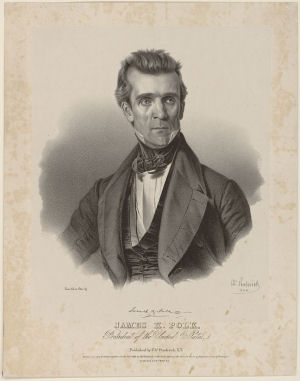
James Knox Polk, President of the United States [1945]
Library of Congress Prints and Photographs Division
Digital ID: ppmsca 07596
Even before he could take office, Congress passed a joint resolution offering annexation to Texas. In so doing they bequeathed Polk the possibility of war with Mexico, which soon severed diplomatic relations.
In his stand on Oregon, the President seemed to be risking war with Great Britain also. The 1844 Democratic platform claimed the entire Oregon area, from the California boundary northward to a latitude of 54'40', the southern boundary of Russian Alaska. Extremists proclaimed "Fifty-four forty or fight," but Polk, aware of diplomatic realities, knew that no course short of war was likely to get all of Oregon. Happily, neither he nor the British wanted a war.
He offered to settle by extending the Canadian boundary, along the 49th parallel, from the Rockies to the Pacific. When the British minister declined, Polk reasserted the American claim to the entire area. Finally, the British settled for the 49th parallel, except for the southern tip of Vancouver Island. The treaty was signed in 1846.
Acquisition of California proved far more difficult. Polk sent an envoy to offer Mexico up to $20,000,000, plus settlement of damage claims owed to Americans, in return for California and the New Mexico country. Since no Mexican leader could cede half his country and still stay in power, Polk's envoy was not received. To bring pressure, Polk sent Gen. Zachary Taylor to the disputed area on the Rio Grande.
To Mexican troops this was aggression, and they attacked Taylor's forces.
Congress declared war and, despite much Northern opposition, supported the military operations. American forces won repeated victories and occupied Mexico City. Finally, in 1848, Mexico ceded New Mexico and California in return for $15,000,000 and American assumption of the damage claims.
President Polk added a vast area to the United States, but its acquisition precipitated a bitter quarrel between the North and the South over expansion of slavery.
Polk, leaving office with his health undermined from hard work, died in June 1849.
Source: The White House: Presidents, James K. Polk 28 November 2009 <www.WhiteHouse.gov>.
Presidential $1.00 coin:
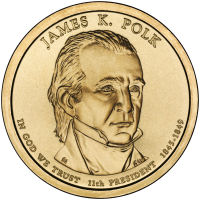
U.S. Mint Image
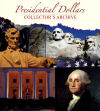
Presidential Dollars
Collector's Archive
James K. Polk, America's 11th President, was born in 1795 in North Carolina. When he was a young boy, his family moved to the wilderness of Tennessee to establish a plantation there. Trained as a lawyer, he served 6 terms in the U.S. House of Representatives, including 4 years as Speaker of the House. After leaving the House, he served as Tennessee governor.
Despite his many years of national service, he was relatively unknown when he was nominated by the Democratic Party to run for President. He was the first "dark-horse" candidate to be nominated by a major political party and won the presidency by a slim margin over Henry Clay.
Polk was a strong proponent of "Manifest Destiny," the belief that the United States had the right to expand throughout the entire continent. He oversaw the growth of the country by more than 1 million square miles during his time in office, including the annexation of present-day Oregon and Washington from Great Britain. Through war with Mexico and the subsequent Treaty of Guadalupe Hidalgo, California and New Mexico were added, and a Texas border on the Rio Grande was established.
A hard worker who rarely delegated even minor tasks, he hardly took a day of vacation while President. Having pledged to serve just 1 term, he left office exhausted from the strains of the presidency. He died in Nashville, Tenn., in 1849, just 3 and a half months after leaving office.
Coinage Legislation under President James K. Polk
- Act of March 3, 1849: This act authorized the coinage of gold dollars and $20 Double Eagles.
United States Mint Directors appointed by President James K. Polk
- President James Polk did not appoint a Director of the United States Mint.
Source: The United States Mint, James Polk Presidential $1 Coin. 28 November 2009 <www.USMint.gov>
Presidential state dollars: Information about design of the Presidential $1 Coins.
Presidential $1 Coins: Release information regarding the Official U.S. Mint Presidential $1 Coins.
Additional Information
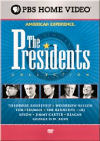
The Presidents
Collection DVD
United States Presidents: List of all United States Presidents from NETSTATE.COM.
James Polk America's Story from America's Library, the Library of Congress.
American Presidents: Life Portraits A Site to Complement C-SPAN's 20th Anniversary Television Series, American Presidents: Life Portraits.
James Knox Polk (1795 - 1849) American President: An Online Reference Resource from the Miller Center of Public Affairs, University of Virginia. In-depth information reviewed by prominent scholars on each President and administration.
James K. Polk Home: The James K. Polk Ancestral Home in Columbia, Tennessee is the only surviving residence of the eleventh U.S. President (excluding the White House). James K. Polk Memorial Association.
James K. Polk: James Knox Polk Biography from the State Library of North Carolina.,
James Knox Polk: The Public Broadcasting Service's "New Perspectives on the West" and James K. Polk.
N.C. Historic Site: James K. Polk Memorial: This site is located on land once owned by the parents of James K. Polk, the 11th U.S. president. The state historic site commemorates significant events in the Polk administration.
Representative James Knox Polk: Biographical information from the Biographical Directory of the United States Congress.
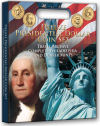
Deluxe Presidential
Dollar Coin
Traveling Archive
Deluxe Presidential Dollar Coin - Traveling Archive , Whitman Publishing (August 7, 2007) Lift off the capsule top, insert the coin, and snap it shut. Now your Presidential dollar is securely stored and attractively displayed - you can even see the coins's edge, which includes the date, mintmark, and inscriptions. Space for both Philadelphia and Denver Mint Coins. Includes Presidential facts printed on the inside flaps. Holds 80 coins - makes a great display and storage unit. (13.375" x 11.5" x 1.0").

Presidential Dollars
Collector's Archive
Presidential Dollars Collector's Archive, Whitman Publishing (August 7, 2007) In December 2005, Congress approved the creation of a new dollar coinage, known as Presidential dollars, and President George W. Bush signed the legislation into law shortly afterward. During each year from 2007 to 2016, four different dollar designs, each bearing the image of a different president, are being released. Living presidents, both current and former, are excluded from the program--thus the roster of presidential honorees currently stands at 37. For these presidents, 38 coins are planned; this is because Grover Cleveland, who to date is the only president to serve multiple nonconsecutive terms, will be represented with two coins. The Presidential dollars are part of the Golden Dollar Program and retain the same golden color as the Sacagawea dollars. The motto IN GOD WE TRUST appears in edge lettering--a first for a U.S. coin, as the motto has never before appeared on the rim. The year of issue is likewise on the rim. Archive Size 11.25" x 10". 40 Openings.
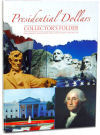
Presidential Folder
Volume I
Presidential Folder 4 Panel - Volume I and Vol II, Whitman Publishing; 1st edition (April 10, 2007) Presidential Folder 4 Panel - Volume I & II Hold P&D Mint Marks. Folder Size 7" x 9,5". Each Volume has 44 Openings - 4 Panels.

James Polk
Mike Venezia
James Polk (Getting to Know the US Presidents), by Mike Venezia. 32 pages. Publisher: Children's Press(CT) (September 2004) Reading level: Grades 3-4. Mike Venezia mixes facts with humor to introduce the presidents of the United States to students. This unique introduction highlights the life and times of President James K. Polk. Venezia uses funny and serious anecdotes to help students understand and realize that presidents are very real people. On each page is either a painting, an engraving, a map, a portrait, or a comical caricature that enhances the text. Captions are included with each that explains the historical paintings and portraits. For reports or pleasure, students will enjoy.

James K. Polk
America's 11th President
Sean McCollum
James K. Polk: America's 11th President, by Sean McCollum. 112 pages. Publisher: Scholastic Library Publishing (March 2004) Reading level: Grades 6-8. A biography of the 11th President of the United States, "Young Hickory." A brief "Fast Facts" includes: time line, glossary, historic sites, Web sites, and index. Books for further reading. Tables of all the presidents noting dates of office, birth, and death, and birth-place.
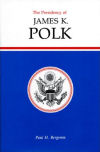
The Presidency of
James K. Polk
Paul H. Bergeron
The Presidency of James K. Polk, by Paul H. Bergeron. 348 pages. Publisher: University Press of Kansas (May 1987) James K. Polk was one of the strongest and most active presidents ever to occupy the office. In the nineteenth century only Jefferson, Jackson, and Lincoln matched his overall leadership and domination of national government. Bergeron's crisp, insightful narrative shows how and why Polk achieved such stature and yet failed to attract the kind of popular support or retrospective recognition granted other presidential luminaries.

James K. Polk
Jacksonian, 1795-1843
Charles C. Sellers
James K. Polk: Jacksonian, 1795-1843, by Charles C. Sellers. 548 pages. Publisher: ACLS Humanities E-Book (August 1, 2008) The standard "life" of Polk. Originally planned as a three-volume work. Reprint. Originally published: Princeton, N.J. : Princeton University Press, c1957-c1966.

James K. Polk
Continentalist, 1843-1846
Charles C. Sellers
James K. Polk: Continentalist, 1843-1846, by Charles C. Sellers. 532 pages. Publisher: ACLS Humanities E-Book (August 1, 2008) The standard "life" of Polk. Originally planned as a three-volume work. Reprint. Originally published: Princeton, N.J. : Princeton University Press, c1957-c1966.
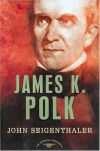
James K. Polk
John Seigenthaler
James K. Polk, by John Seigenthaler. 208 pages. Publisher: Times Books; 1st edition (January 4, 2004) James K. Polk was a shrewd and decisive commander in chief, the youngest president elected to guide the still-young nation, who served as Speaker of the House and governor of Tennessee before taking office in 1845. Considered a natural successor to Andrew Jackson, 'Young Hickory' miraculously revived his floundering political career by riding a wave of public sentiment in favor of annexing the Republic of Texas to the Union. Shortly after his inauguration, he settled the disputed Oregon boundary and by 1846 had declared war on Mexico in hopes of annexing California. The considerably smaller American army never lost a battle. At home, however, Polk suffered a political firestorm of antiwar attacks from many fronts. Despite his tremendous accomplishments, he left office an extremely unpopular man, on whom stress had taken such a physical toll that he died within three months of departing Washington. Fellow Tennessean John Seigenthaler traces the life of this president who, as Truman noted, 'said what he intended to do and did it.'



